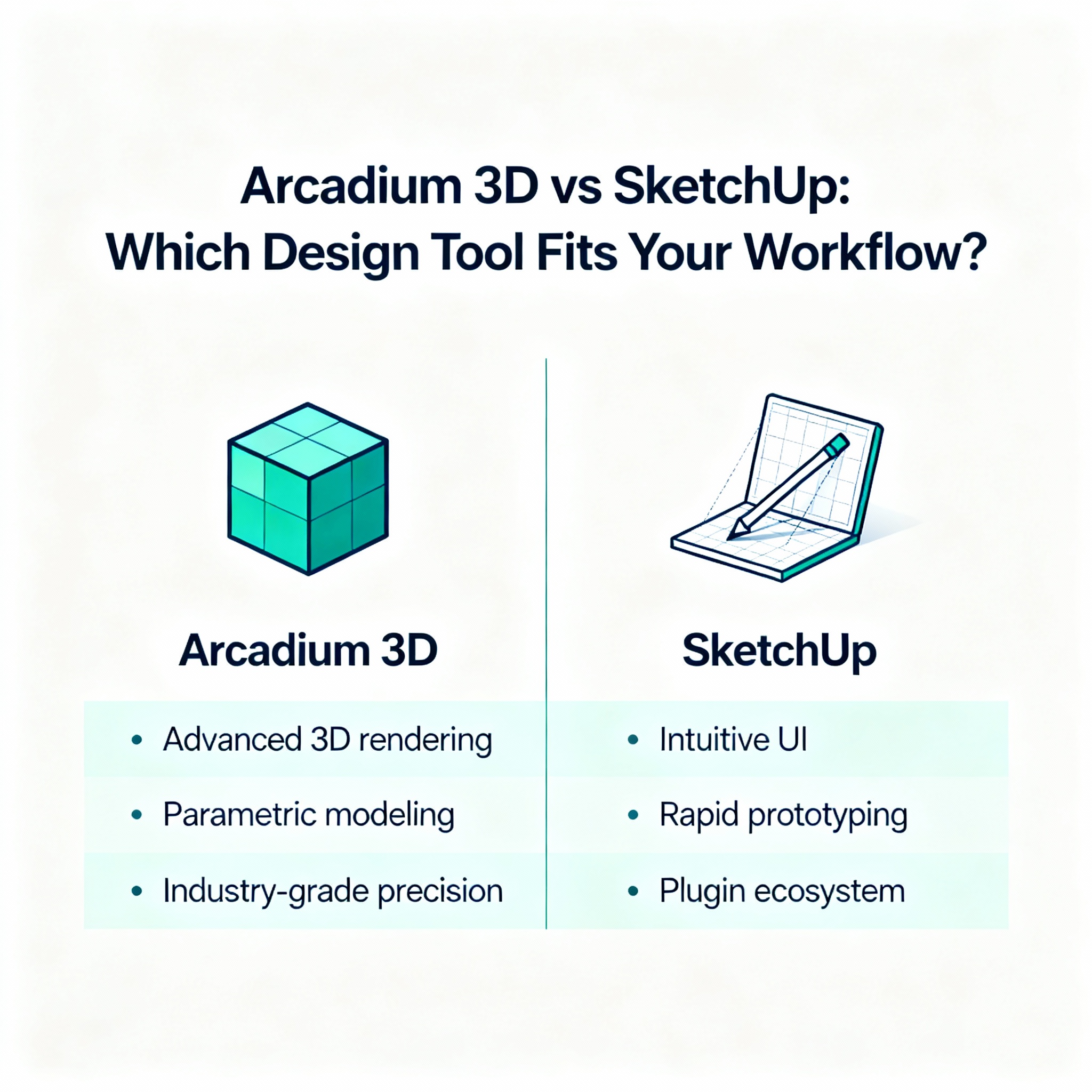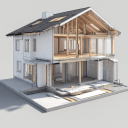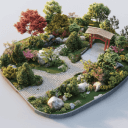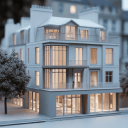Choosing the right 3D design software is crucial for architects, designers and DIY enthusiasts. SketchUp is a mature, professional-grade modeling tool trusted by architects, builders, and designers worldwide.
In contrast, Arcadium 3D is a newer browser-based platform designed for fast home and interior design; it combines parametric furniture, real-time rendering, and AI-powered visualizations out of the box. With such different approaches, users must weigh factors like ease of use, speed, collaboration, and cost.
This article compares Arcadium 3D and SketchUp side by side, from setup and learning curve to AI features and pricing, to help you decide which tool fits your workflow best.
Quick Comparison For You
Feature
| Arcadium 3D
| SketchUp
|
Platform
| Browser-based (works on any device, no install needed) | Web (limited free) + Desktop (Pro requires macOS/Windows). |
Learning Curve
| Very short, intuitive drag-and-drop with guided tips | Moderately powerful tools but steeper for new users. |
Parametric Tools
| Yes, dynamic walls/furniture resize automatically | No built-in parametrics; modeling is manual push/pull. |
AI & Rendering
| Built-in AI interior styling and real-time photoreal renderer | No native AI or high-end render; requires external plugins. |
Library Quality
| Large built-in modern library; materials easily swapped | Very large 3D Warehouse (millions of models); quality varies. |
Sharing/Collab
| Instant URL links; viewers need no login; cloud versioning | Share view-only links; real-time comments require a Trimble account. |
Pricing
| Core 3D tools are free. Paid plan ($20/mo) adds high-res exports | The free web version is basic. SketchUp Go ~$119/yr, Pro ~$299/yr for full features. |
Best For
| Quick mockups and floor plans, interior layouts, non-experts, and fast ideation | Detailed architecture or CAD work, advanced modeling, and users leveraging the extensive plugin ecosystem. |
Overview
Arcadium 3D is a fast, easy 3D house design tool that runs entirely in a web browser. It requires no downloads or installations and offers a free entry plan with core features. The software includes built-in libraries of scaled furniture and dynamic parametric components (walls, stairs, windows, doors) that adjust automatically as you draw.
Users praise Arcadium’s intuitive interface and online accessibility; one review notes it “combines fast and easy 3D model creation with parametric editing and precision,” enabling designers to experiment more and spend less time wrestling with software.
SketchUp, on the other hand, is a robust 3D modeling suite available in both a free web version and paid desktop editions. It is designed for a wide range of uses, from quick conceptual sketches to detailed architectural plans. SketchUp’s strength lies in its extension ecosystem and massive 3D Warehouse: it offers over 4 million pre-built models and materials (appliances, furniture, textures, etc.) to jumpstart designs.
However, SketchUp’s desktop Pro version must be installed (macOS/Windows), and its full features are unlocked only via subscription. In summary, Arcadium focuses on speed and simplicity in a browser environment, while SketchUp provides a powerful desktop-based modeling toolkit.
Ease of Use
Arcadium is built for beginners and fast prototyping. You can sketch walls and place furniture in minutes, thanks to a hybrid 2D/3D workflow and drag-and-drop tools. Tooltips guide new users through tasks like drawing walls and inserting doors, so you don’t need lengthy tutorials.
The interface is clean and uncluttered, with on-screen measurements and snapping for precision. In practice, Arcadium “delivers the shortest path from blank canvas to usable plan,” making it ideal for homeowners and real-estate pros who want quick results.
SketchUp offers greater power but a steeper learning curve. Its classic pull/push modeling system is intuitive for experienced users, but novices must manage 3D navigation from the start, orbiting the camera, locking axes, and handling inference points. In SketchUp Free (the web version), new users often struggle with the complexity of the 3D workspace and grouping objects.
In short, SketchUp can model almost anything, but getting up to speed takes longer. Many users report that SketchUp is “industry-standard,” but the effort is noticeable: it requires more clicks, layers of menus, and modeling know-how. By comparison, Arcadium’s approach sketch in plan view, then instantly “walk” the space, is much more beginner-friendly.
Features and Tools
Parametric vs Manual Modeling:
Arcadium’s standout feature is its parametric components. Walls, doors, windows, and furniture automatically scale and adjust to your layout. For example, stretching a sofa will duplicate cushions or adjust its length automatically. Numeric input allows millimeter precision on any dimension.
In contrast, SketchUp uses traditional push-pull and manual scaling. There is no built-in parametric library in SketchUp Free; you create objects by hand or find downloadable “live components” in the 3D Warehouse. This means SketchUp can be extremely precise, but editing objects (like changing a cabinet’s size) often requires re-modeling or installing special plugins.
Object Library:
Arcadium’s built-in library includes thousands of modern furniture and decor items (sofas, cabinets, appliances, lighting, etc.), with new assets added frequently. Materials and colors are fully editable: you can change fabrics, wood grains or metal finishes with one click, or even import custom textures to match vendor samples.
SketchUp, by contrast, provides the 3D Warehouse, a community-driven repository of millions of models. The Warehouse’s breadth is impressive, but quality varies widely. Importing very large or complex models from the Warehouse can also slow down performance. Material editing in SketchUp requires manually painting faces, which is more time-consuming than Arcadium’s quick-swap approach.
2D/3D Flexibility:
Both tools support multi-view design. Arcadium lets you toggle between top-down floorplan, isometric, and a first-person walkthrough view on the fly. SketchUp also offers top, front, side, and perspective views, and its desktop edition includes LayOut for 2D drawings.
However, Arcadium’s learning curve in switching views is very shallow (one click changes view), whereas SketchUp beginners may need training to fluently switch among views and use its documentation features.
AI and Visualization
Arcadium includes an AI Interior Design tool that can instantly transform any room view into high-quality renderings or stylized images. You simply take a snapshot of your 3D model and choose an output style: Arcadium can generate a photorealistic image, a line-art sketch, a watercolor-like rendering, or other design iterations within seconds. This AI rendering happens right in the browser, there’s no separate export or long render times.
You can test different lighting, furniture, or materials and get near-instant feedback on how a room will look. The built-in real-time renderer is physically based: sunlight, shadows and reflections update live as you adjust the scene.
SketchUp does not have a built-in AI image generator or live photoreal rendering engine. Its native renderer is simple (for basic shading), so professionals typically export models to specialized rendering plugins such as V-Ray, Enscape, or Lumion for high-quality output. These external plugins produce impressive results, but they add cost (many are paid), require separate installation, and involve waiting for renders to finish.
In SketchUp’s free web version, no native photo rendering is available at all. In summary, Arcadium’s AI tools and instant PBR rendering let you visualize designs quickly from multiple angles, whereas SketchUp demands extra tools and steps for comparable visualization.
Collaboration and Sharing
Arcadium excels at instant sharing. Every project lives in the cloud, and designers can generate a one-click URL to share with clients, colleagues, or contractors. Viewers don’t need to log in or install software the link opens an interactive walk-through of the model. Stakeholders can virtually “tour” the design, leave comments, or even make minor edits if allowed.
Every change is automatically versioned in the cloud, so it’s easy to revisit earlier designs or test alternatives. Because Arcadium is fully online, collaboration happens in real time with minimal hassle.
SketchUp’s collaboration features are more limited, especially on the free tier. You can share a SketchUp model by uploading it to Trimble’s 3D Warehouse or by using Trimble Connect (a cloud service), but recipients usually need an account to view or comment in real time.
In the free web version, you can share “view-only” links, but live commenting and teamwork features typically require at least a paid Go subscription. In practice, this means Arcadium provides a much more frictionless client review process out of the box. One reviewer notes that Arcadium’s “frictionless link-sharing accelerates client approvals” in time-sensitive projects; this ease of sharing is a big advantage.
Arcadium’s free tier is generous: it lets you create fully featured designs (up to one project) at no cost. You only pay if you need extra exports (like CAD) or high-resolution photorenders. SketchUp’s free plan gives basic modeling in a browser, but serious users often upgrade.
Trimble’s SketchUp Go (cloud-based) and Pro (desktop) subscriptions unlock collaboration, advanced tools, and 2D documentation, at roughly $119-$299 per year. In short, Arcadium offers powerful capabilities with zero budget, while SketchUp requires a paid plan to reach similar professional levels.
Which Should You Choose?
If your priority is speed, ease, and collaboration, Arcadium 3D is a strong fit. Its browser-based nature means you can get started instantly on any device, and clients can view designs with a single link. The parametric furniture library and live renderer let you generate polished interior designs quickly, even the AI-style images are just a click away. Arcadium works especially well for interior designers, real-estate professionals, and DIY home renovators who need to iterate layouts fast without a steep learning curve.
SketchUp is preferable when you need deep modeling power and extensibility. It has become an industry standard for architectural modeling, landscape design, and any scenario requiring custom geometry or 2D documentation. Its massive 3D Warehouse and hundreds of plugins (600+ extensions are available) allow for virtually any design need.
However, this flexibility comes at the cost of complexity and (for many features) subscription fees. Professional studios that already use SketchUp for workflow continuity may stick with it, especially if they need advanced plugins like V-Ray or LayOut. In contrast, Arcadium shines when you want an accessible, all-in-one platform that handles most design tasks out of the box.
In summary:
For quick, browser-based design with AI assists and easy sharing, Arcadium 3D offers real strengths. For full-fledged 3D modeling and deep customization, SketchUp remains a solid choice, albeit with a longer setup and learning process. Evaluate which factors matter most and consider trying Arcadium’s free version firsthand to see if its speed and simplicity fit your workflow.
Frequently Asked Questions
What is the main difference between Arcadium 3D and SketchUp?
Arcadium is a browser-based home design tool focused on ease and speed. It provides parametric furniture, real-time rendering and AI image tools right in the web app. SketchUp is a desktop/web 3D modeling platform known for its powerful geometry tools and extensive plugin ecosystem. In short, Arcadium targets quick interiors and layouts with minimal setup, while SketchUp aims at detailed architectural modeling.
Is Arcadium free to use?
Yes. Arcadium’s core design tools are free. You can build unlimited floor plans, use the full furniture library, and share designs without paying. (The free plan does limit you to one active project at a time.) Paid plans only apply if you want high-resolution exports, CAD downloads, or additional projects. SketchUp has a free web version, but its advanced features require a paid subscription.
Can I do AI-powered rendering in SketchUp?
Not natively. SketchUp itself doesn’t include built-in AI styling or realistic rendering. Designers usually export SketchUp scenes to external renderers (like V-Ray, Enscape, or Lumion) to get photorealistic images. Arcadium, by contrast, has its own AI image generator and live renderer in the browser.
Which tool is better for beginners?
Arcadium is generally easier for newcomers. Its interface is intuitive and guided, so users can start designing with minimal training. SketchUp is also known for being approachable, but beginners may find its 3D controls and menus more challenging at first. Both have large communities, but Arcadium’s learning curve is designed to be shorter.
Can I share designs with clients easily?
Arcadium excels here. Every project in Arcadium can be shared instantly via a web link; clients can view and walk through the model without any login. SketchUp models can be shared too, but typically require viewers to have a compatible SketchUp viewer or account. For real-time comments and collaboration in SketchUp, you may need a paid Trimble subscription.
Is SketchUp better for large or complex projects?
SketchUp can handle large models and complex geometry (especially with extensions), but performance depends on hardware. Its unlimited precision modeling is powerful. Arcadium can handle moderate projects very well and is continuously improving, but it is optimized for speed and ease. For massive CAD-level projects or detailed BIM workflows, professional CAD/BIM tools or SketchUp Pro might be more appropriate.
How do pricing models compare?
Arcadium offers a free tier for everyone (with optional paid add-ons at around $20/month). SketchUp’s pricing is tiered: a free web version, a mid-level “Go” subscription (~$119/yr), and a full “Pro” subscription (~$299/yr). In general, if budget is a concern, Arcadium provides core functionality at no cost, whereas unlocking SketchUp’s full feature set requires paid plans.
You can check our other comparison contents:
Arcadium 3D vs RoomSketcher: Floor Plans to First-Person Tours
Arcadium 3D vs Homestyler: Browser Performance With Large Rooms
Arcadium 3D vs Floorplanner: Sharing Links and Client Walkthroughs
Arcadium 3D vs Cedreo: DIY Speed versus Professional Design Outputs
Arcadium 3D vs HomeByMe: Which Platform Balances Speed, Control, and Visual Power Best
Arcadium 3D vs Sweet Home 3D: Which Design Platform Delivers Speed, Flexibility, and Visual Impact
Arcadium 3D vs Roomstyler: Choosing the Right Tool for Speed, Precision, and Creative Freedom
Arcadium 3D vs Planner 5D: Which Design Platform Delivers More for Modern Creators
Arcadium 3D vs SmartDraw: Floor Plans, Elevations, and Exports


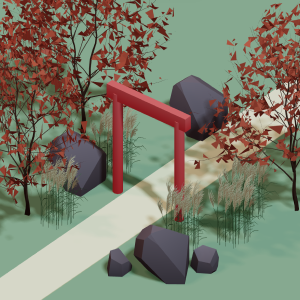 All training, tips and articles
All training, tips and articles
 3D house design tool
3D house design tool
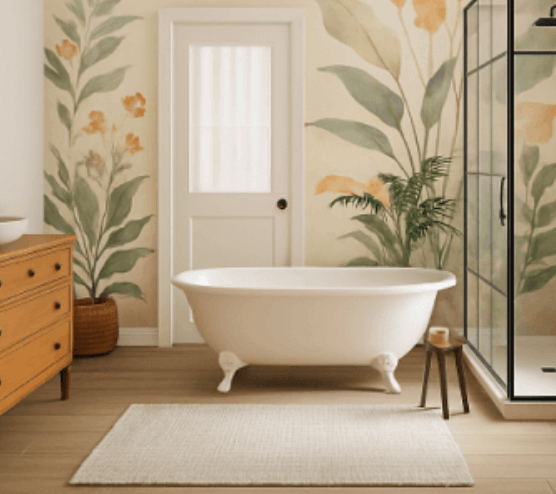
 Color palette generator
Color palette generator
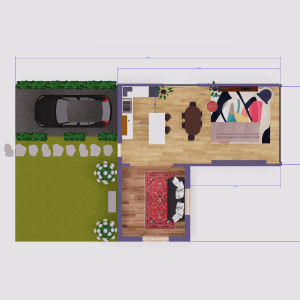 Floor plan creator
Floor plan creator
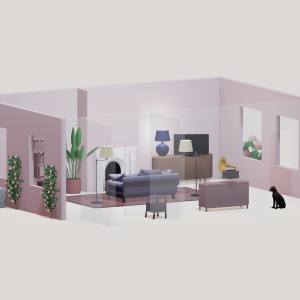 Interior design app
Interior design app
 Kitchen design tool
Kitchen design tool
 House design software
House design software
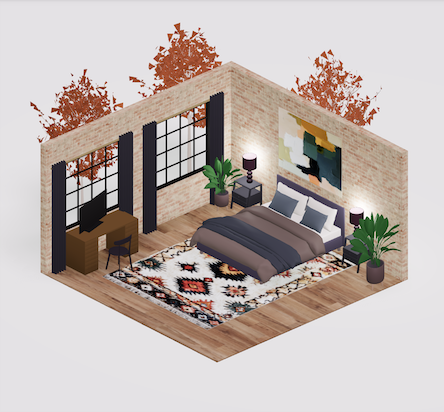 Room designer
Room designer
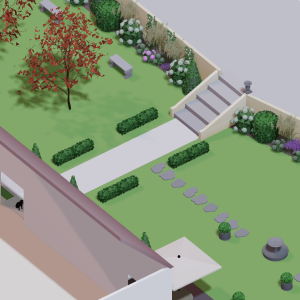 Landscape design software
Landscape design software
 Bedroom design
Bedroom design
 Office floor plan creator
Office floor plan creator
